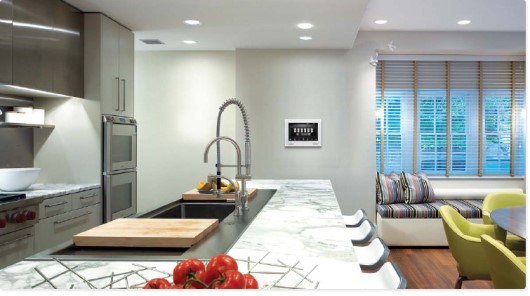Smart homes provide automated functionality and cost-savings to homeowners who recognize the value of saving time and money. Smart homes have automated lighting, heat, appliances, air conditioning, television, audio, and video components. The best part about automated technology is the ability to control it via smart phone, laptop, or computer from any location in the world. This gives homeowners the ability to achieve the perfect comfort level before returning home from work or vacation and the extra security when they know their home is safe while they are away. Here are some examples of what it means to have a smart home.
Control Lights Remotely
Remote control of lights can be good for a variety of reasons. Some home owners use this feature to turn lights on at various times during the day and night to make it appear as if the inhabitants are home. Other homeowners may turn on the lights in the home before they arrive to avoid fumbling around in the dark. This feature keeps the utility bills low by conserving energy when people are not in the home.
Control Heat and Air Remotely
Did you know that you can also control heat and air remotely? This feature also saves money in a smart home. There is nothing worse than going on vacation and coming home to a home that is either sweltering hot or freezing cold. With remote operation, you can gradually bring the home to a comfortable temperature before you return. This process will also save money and is better on the environment.
Timers and Safety Measures for Kids and Elderly
Home automation can help you monitor electricity usage even with kids. When they leave the lights on or the television, the timer will automatically turn them off at a particular time. The temperature can also be regulated depending on when someone is home.
Elderly can also benefit from a smart home because automated appliances can save their lives. A gas stove that turns off automatically can prevent an untimely death. Turning off a faucet with a timer can also keep an elderly person from drowning or flooding their home.
Ability to Monitor Usage
You can monitor your usage with remote devices and computers. The monitoring systems calculate and log usage on all devices connected to the unit. This gives the home owner a better understanding of how energy is used in the home and modifications can be made to modify usage. These systems operate in the cloud and can be accessed via the Internet from any location in the world. If you don’t have a suitable internet yet, consult with your local internet providers or refer to http://www.satellitestarinternet.com/hughes-net/.
Biometric or Coded Entry
You can also allow maintenance men, technicians, or guests to enter your home while you are away. Instead of leaving a key under the mat and changing the locks periodically, try giving your guests and maintenance men a temporary code that will alert you when the person enters the home. You can watch them on closed circuit television until they finish their jobs, and then, when they are finished, you can deactivate the code. This allows maximum safety with minimal effort. A fingerprint scan or biometric scan is also a safer method of protecting the home.
Video Door Monitoring
Video door monitoring can keep the home safe by providing a visual of who is entering and exiting the home. Even if you are not home, you can see who is ringing your doorbell from a smartphone or laptop. This provides homeowners ultimate protection and security. This is one aspect of a smart home that most people find significantly useful.
Look Into the Future With a Smart Home
With a smart home, you can make your home energy-efficient and also cost-effective. Inquire and learn more about how a smart home can improve your life. You will be pleased with smart home technology.

